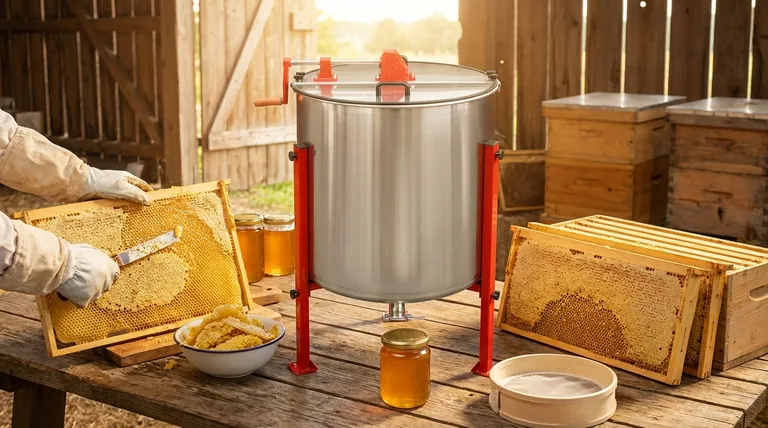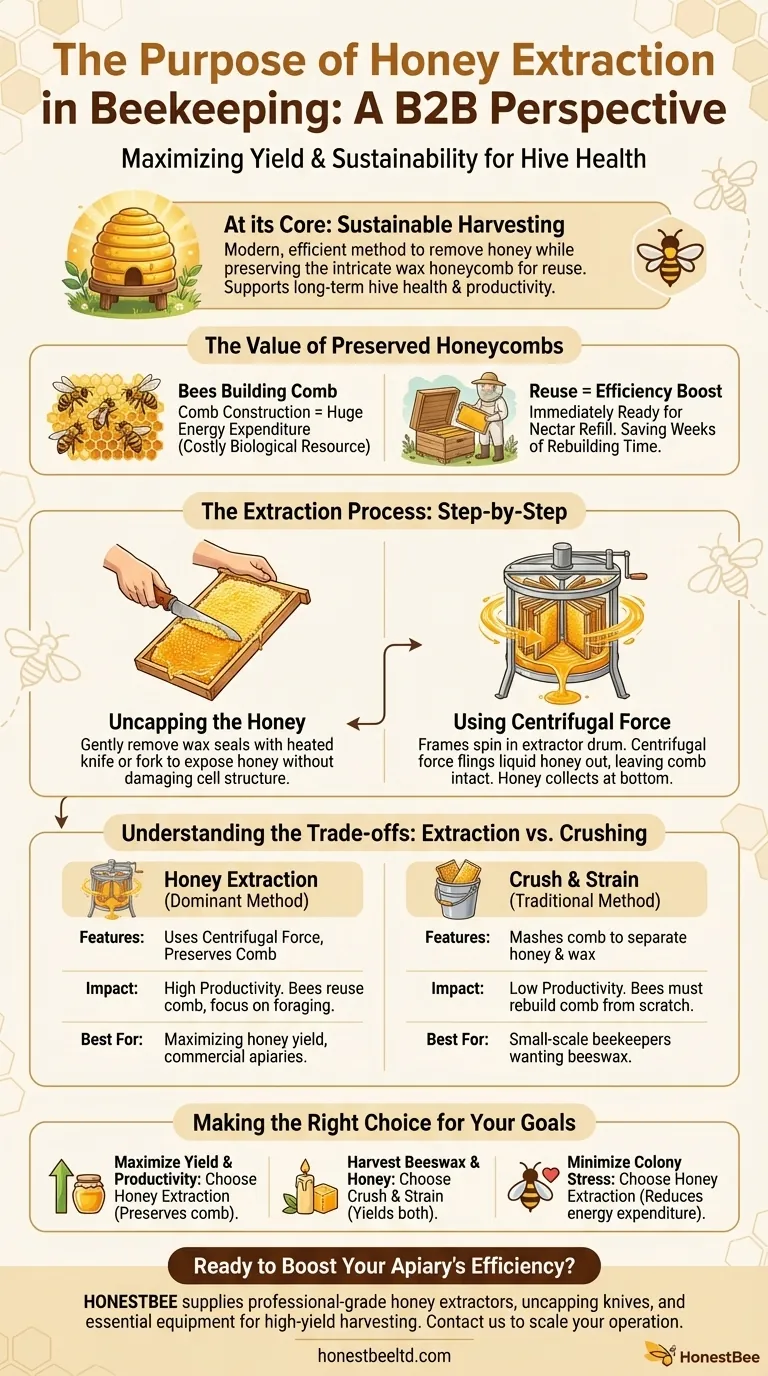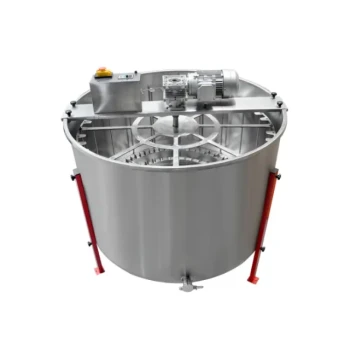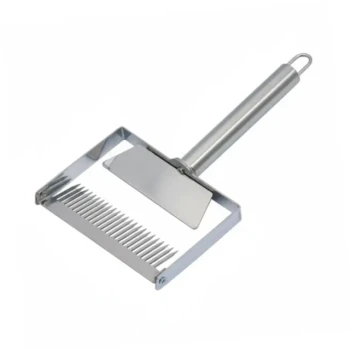At its core, honey extraction is the modern, efficient method for removing honey from honeycomb. Its primary purpose is to harvest the honey while preserving the intricate wax honeycomb, allowing the bees to reuse it.
The true goal of honey extraction isn't just to get honey; it's to harvest it sustainably. By using centrifugal force to remove honey without destroying the comb, beekeepers support the long-term health and productivity of the hive.

The Principle Behind Extraction: Working With the Bees
Understanding honey extraction begins with appreciating the immense effort bees put into building their home. The process is designed to respect and leverage the natural structure of the hive.
Why Honeycombs Are So Valuable
A bee colony expends a tremendous amount of energy to produce wax and construct a honeycomb. For bees, wax is a costly biological resource.
By preserving this comb, the beekeeper gives the colony a massive head start. The bees can immediately begin refilling the empty cells with new nectar rather than spending weeks rebuilding the comb from scratch.
Step 1: Uncapping the Honey
Before extraction, each honey-filled cell is sealed with a fresh wax capping by the bees. The beekeeper must first gently remove these cappings.
This is typically done using a heated uncapping knife or a specialized fork-like tool called an uncapping scratcher. The goal is to slice off only the top layer of wax, exposing the honey beneath without damaging the underlying cell structure.
Step 2: Using Centrifugal Force
The uncapped frames are then placed vertically into a honey extractor, which is essentially a large drum that spins the frames at high speed.
This spinning motion generates centrifugal force, which flings the liquid honey out of the cells and onto the inner wall of the extractor. The honey then runs down the wall and collects at the bottom, ready to be filtered and bottled. The empty but intact combs are then returned to the hive.
Understanding the Trade-offs: Extraction vs. Crushing
While extraction is the dominant method today, it's not the only way to get honey from a comb. Understanding the alternative highlights why extraction is so widely adopted.
The "Crush and Strain" Method
The traditional, low-tech alternative is the crush and strain method. This process involves scraping the entire honeycomb into a bucket, mashing it up to break open the wax cells, and then straining the mixture to separate the honey from the wax debris.
The Downside of Crushing: A Total Reset for the Bees
While simple, the crush and strain method completely destroys the honeycomb. The bees must start from zero, consuming significant honey stores to produce the energy needed to build new wax combs.
This rebuilding phase diverts the colony's resources away from gathering nectar, often resulting in a significantly lower honey yield for the next harvest.
The Benefit of Extraction: A Boost in Productivity
Extraction avoids this "reset." By returning the empty, drawn-out combs to the hive, the beekeeper enables the bees to focus exclusively on foraging and honey production. This efficiency is the single greatest advantage of honey extraction.
Making the Right Choice for Your Goal
Your harvesting method depends on your goals, scale, and philosophy as a beekeeper.
- If your primary focus is maximizing honey yield and long-term hive productivity: Honey extraction is the definitive choice, as it preserves the valuable honeycomb.
- If you are a small-scale hobbyist and also want to harvest a larger quantity of beeswax: The crush and strain method is a viable option that yields both honey and a significant amount of wax.
- If your priority is minimizing stress on the colony: Returning empty combs after extraction reduces the energy expenditure required from the bees, allowing them to thrive.
Ultimately, choosing the right method is about balancing your needs with the biological needs of your honeybee colony.
Summary Table:
| Method | Key Feature | Impact on Hive | Best For |
|---|---|---|---|
| Honey Extraction | Uses centrifugal force; preserves comb | High Productivity. Bees reuse comb, focus on foraging. | Maximizing honey yield, commercial apiaries |
| Crush & Strain | Mashes comb to separate honey and wax | Low Productivity. Bees must rebuild comb from scratch. | Small-scale beekeepers wanting beeswax |
Ready to Boost Your Apiary's Efficiency?
As a commercial beekeeper or distributor, maximizing hive productivity is your bottom line. HONESTBEE supplies the professional-grade honey extractors, uncapping knives, and other essential equipment you need to implement efficient, high-yield harvesting.
Our wholesale-focused operations ensure you get the reliable, durable gear that supports sustainable beekeeping and maximizes your honey production season after season.
Contact HONESTBEE today to discuss your equipment needs and scale your operation.
Visual Guide

Related Products
- 6 Frame Manual Stainless Steel Honey Extractor Beekeeping Equipment
- electric honey extractor honey centrifuge 3 frame honey extractor stainless steel honey frame extractor
- HONESTBEE 3-Frame Manual Acrylic Honey Extractor
- Stainless Steel 3 Frame Manual Honey Extractor Spinner for Bee Honey Extraction
- 2 Frame Stainless Steel Manual Honey Spinner Extractor for Beekeeping
People Also Ask
- What tips can maximize honey extraction efficiency? Unlock Higher Yields and Purer Honey
- How many frames can different types of honey extractors hold? Maximize Your Harvest Efficiency
- Which type of extractor is more suitable for hobbyists or small-scale beekeepers? Find the Perfect Fit for Your Apiary
- What are the differences between manual and automatic honey extractors? Choose the Right Tool for Your Apiary
- What is the relationship between beeswax harvesting and honey extraction? An Inseparable Process Explained



















